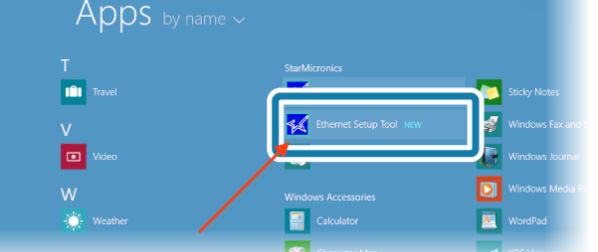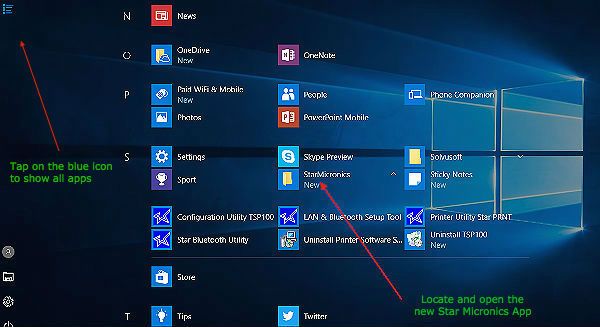Connect the printer to the mains power. Using an Ethernet cable connect the printer to your router. While holding down the 'FEED' button turn theprinter on using the switch on the left hand side of the printer. It will self print it's settings, pause with the lights flashing while it acquires a connection then print out it's IP Address. The bottom of the self print should look like this.


There is a dedicated Application, TSP100III Utility (futurePRNT), which you can use to easily setup this printer. You can download this App from the following link by clicking on it or copying and pasting it into a browser on your Windows device. It also downloads the 'Configuration Utility TSP100', the printer driver and the 'LAN & Bluetooth Setup Tool'.
https://starmicronics.com/support/products/tsp100iii-support-page/


You can use this app to search for the network printer and connect to it, provided the printer is connected on your network. It can also be used to change the network settings of the connected printer to give it a static IP Address. Once a static IP address is assigned, IP address changes through your router will not occur. This means that once setup you will be able to continuously use the same IP Address for your printer.
Having downloaded the TSP100 III Utility go to your Windows Start menu and open the Application 'Configuration Utility TSP100'. You may receive a popup to say 'No USB printers detected Click ok to proceed to install LAN printer'. Click OK and the popup will change as it searches for connected printers.


When your printer is found by the Utility it will appear in your list of attached Star printers. Select the device to be connected ( 1 )


and then click on the Configuration button ( 2 )
This connects your Windows machine to the selected printer and opens the Web Configuration Utility.
At this point your Windows machine is connected to your printer and can now be configured on AirPOS or you can assign a static IP Address to the printer with a couple of clicks. To do this from the left panel of the Web Configuration Utility screen tap on 'Login'.


Enter the login details as shown below with 'root' as the default username and 'public' as the password. You'll probably be prompted to change the login credentials. Press 'OK' to change them or 'Cancel' to leave them as default.

Now tap on 'IP Parameters' from the left of the refreshed screen and tap on 'Static' as shown below. Type the IP Address that you want to use. You should use the IP Parameters you got from the self print as you know that the IP Address would not have been assigned if there was a conflict with another device on your network. When you've entered the IP Address, Subnet Mask and Default Gateway tap 'Submit' as shown below.


The 'Save' button in the left panel will start to flash red prompting you to save. Tap on that.


You should see the following screen.


Press the execute button. This will save the settings and reboot the printer which will self print it's connection settings. Beside IP Address it should now read (Static) on the self print.


One task remains but it is an important one.
In order to properly parse and format your receipts the printer needs to be put into what's know as 'ESC/POS' mode so that it can properly respond to commands from your POS. To do this you'll need to open the 'Configuration Utility TSP100' from your list of Windows programs which will have been downloaded with the printer driver. On earlier versions of Windows click on the 'Start' button and then on 'All Programs'. Scroll down until you see 'Star Micronics' and click on it to expand it.
On Windows 10 tap on the icon to show All apps and locate 'Star Micronics' as shown below.

Click on 'Star Micronics' to expand it and select 'Configuration Utility TSP100'. After a few moments a popup like the one shown below will appear.

Click or tap on 'ESC/POS Mode' and press OK. It may appear not to be doing anything but after a few moments the screen will change to one like that below.

From the left navigation panel click on 'Print Job Routing' and the screen will change again.

Click in the box beside 'Enable ESC/POS Routing' and press the 'Apply Changes' button.
When I click 'Configuration Utility' the 'Select an emulation' window doesn't appear!
If the window to switch to ESC/POS doesn't appear when you open the configuration utility app, as shown in the example above. Simply follow these steps:
Select the printer that you have successfully connected to your network again.
Click on 'Printer Queue' to open it

Make sure to tick the box labeled 'Set as default printer'. This ensures that the printer is selected for the configuration process. You can also check the box for 'Print test page'. This will confirm that the printer has been successfully connected. If a test page doesn't print, please check for any errors like a paper jam or no paper.
Once both boxes are ticked, click 'Apply'

You should then see a window like the image below.

Click on 'Yes', and it will take you to the 'Select an emulation' window. From there, you can refer back to the previous part of this article to connect your printer successfully!
Connect your printer to AirPOS
Your printer is now setup on your Windows machine and it remains only to configure it on AirPOS. Open the AirPOS application and click or tap on the settings cogwheel at the top of the screen. From the left margin select 'Peripherals'. When you press the 'Add Printer' button any printers setup on your Windows machine will be displayed in a blue box (you may see your office printer or other printers added on Windows listed). Tap on the printer you've just added and press 'Next'.

In the next popup you'll be asked for the printer type. Tap on the option for the 'Star TSP-650 orTSP-100 series' and click on the 'Use this printer' button to save the printer in AirPOS.
